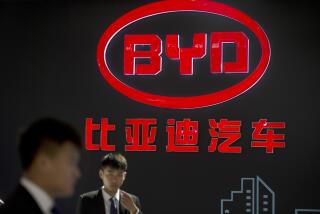In China, fake phones are losing appeal
Reporting from Beijing — Xiong Mingjian is often crushed into a corner during his tedious subway commutes, but passing the time has been easy since he bought a nifty new cellphone.
The 27-year-old store clerk surfs the Internet and taps away at games on his Motorola Defy, one of an increasing number of popular high-end mobile phones that are helping China shed its label as a knockoff haven.
For years, copycat cellphones have thrived in a country famed for counterfeiting many things, such as Gucci handbags, Hollywood DVDs and, most recently, Apple retail stores. It’s a market fed by shadowy factories turning out low-cost models bearing names such as BlockBerry and HiPhone 4.
But Chinese bootleggers are now losing ground to the iPhones and other high-end gadgets they once copied.
“People want the real thing,” said Guo Feilong, a vendor at a massive electronics market in northwest Beijing where hundreds of closet-size stalls sell genuine and pirated phones. “Prices have gone down so much, why would anyone need to buy a fake?”
Falling prices for brand-name models are just one reason crude clones are becoming passe.
Chinese consumers increasingly want devices that allow them to surf the Web, play games and download apps, a level of sophistication that’s tough for some low-rent producers to deliver. Some upwardly mobile city dwellers wouldn’t dare risk losing face by carrying a knockoff phone.
Factory orders for unlicensed phones, better known in China as shanzhai, or outlawed, phones, have been declining rapidly over the last few years, according to market researcher IHS iSuppli.
Slightly more than 24 million shanzhai phones were ordered in China last year; that’s down about half from the peak in 2007 when the devices accounted for 20% of all shipments. Today, shanzhai handsets represent just 7% of new factory orders for phones and could be half that within a few years.
Meanwhile, smartphone sales are soaring. More than 131 million are in use in China, up from 52 million in 2009, according to Analysys International, a Beijing research firm. The average price has dropped below $300, putting them within reach of white-collar workers.
“After playing with my friends’ smartphones, I had to get one of my own,” said Xiong, gripping a $275 touch-screen Motorola handset outside a Beijing subway station. “I would never buy a fake one because it wouldn’t be able to do the same things.”
The trend bodes well for brands such as Apple, Finland’s Nokia and South Korea’s Samsung, which are battling Chinese makers to capture a greater share of the world’s largest cellphone market.
“We’re looking at a billion [Chinese] cellphone users in the next couple of years,” said David Wolf, chief executive of Wolf Group Asia, a Beijing consulting firm. “As important as North America and Europe has been for mobile devices, soon we’ll see the tail wagging the dog. Chinese consumers will eventually dictate what the rest of the world will use.”
Indeed, major parts manufacturers are developing their own smartphones for the Chinese market that will be significantly cheaper than current offerings. Apple reportedly is working on a lower-cost, mass-market Chinese iPhone; the company did not respond to requests for comment.
It all spells trouble for cellphone counterfeiters, whose hub is the southern industrial city of Shenzhen. Aided by China’s weak protection of intellectual property and an abundant supply of low-cost semiconductors, hundreds of factories sprouted over the last decade, churning out knockoff handsets. These manufacturers found buyers not only in China but also in emerging markets in Africa and the Middle East.
International pressure led to periodic crackdowns by Chinese authorities. Bad press about exploding batteries and high radiation in some flimsy phones scared off some customers as well.
Declining profits spurred some counterfeiters to turn to making knockoff tablet computers instead. But others have decided to go legitimate by developing their own high-end cellphones.
Wanxiang, a Shenzhen company that makes and sells shanzhai handsets such as the iPhome A8, is planning to release a trademarked 3G smartphone this year that sells for $230. The manufacturer has gone so far as to develop an online app store, hoping that users will get hooked on the firm’s software.
“Everyone can use the same hardware and offer the same prices, but to stay competitive you need your own applications and R&D,” said Nuo Long, a Wanxiang manager. “So we decided to invest. This year alone, at least 60 or 70 phone makers registered new brands and trademarks.”
Nuo said the company was inspired by two upstart Chinese phone makers generating buzz for their surprisingly capable devices. Meizu and Xiaomi have both developed phones aimed to compete with Apple.
The Xiaomi phone, which is priced at $312 and uses Google Android software, is half the price of an iPhone sold in China and boasts the most powerful processor ever installed on a mobile handset.
Oded Shenkar, a China specialist at Ohio State University and author of “Copycats: How Smart Companies Use Imitation to Gain a Strategic Edge,” said none of this is especially odd. Chinese manufacturers are now poised to begin innovating after years of replicating foreign products and business models, he said.
“Chinese phone makers are learning to play the game by putting a twist on existing technology and putting a patent on it,” Shenkar said.
“Being able to take a blueprint and turn it into a product in a very quick time will serve you very well when you eventually have your own concept,” he said. “China is not the first or only imitator, but it’s the first imitator that has tremendous capability.”
Still, demand for shanzhai phones remains strong in rural areas and among migrant workers earning only a few hundred dollars a month.
“People in China are practical,” said CK Lu, an analyst with research firm Gartner Inc. “It’s not shameful to use fake phones any more than it is to carry a fake Louis Vuitton bag.”
Tommy Yang in The Times’ Beijing bureau contributed to this report.
More to Read
Inside the business of entertainment
The Wide Shot brings you news, analysis and insights on everything from streaming wars to production — and what it all means for the future.
You may occasionally receive promotional content from the Los Angeles Times.










